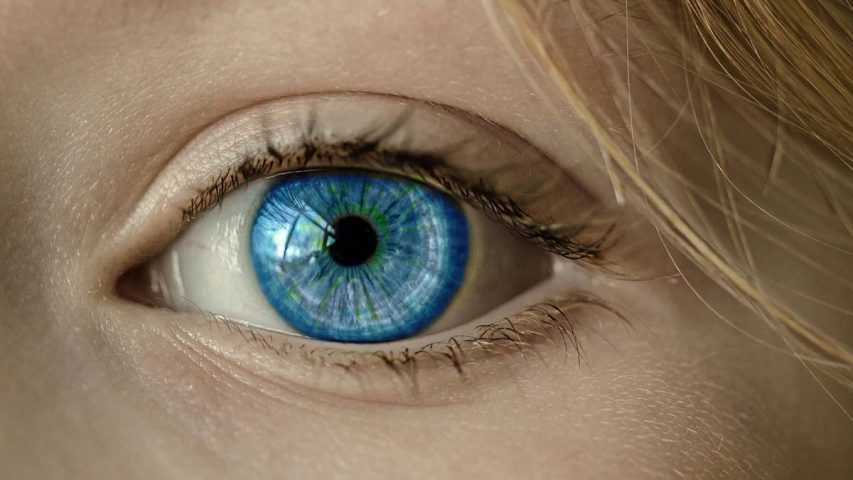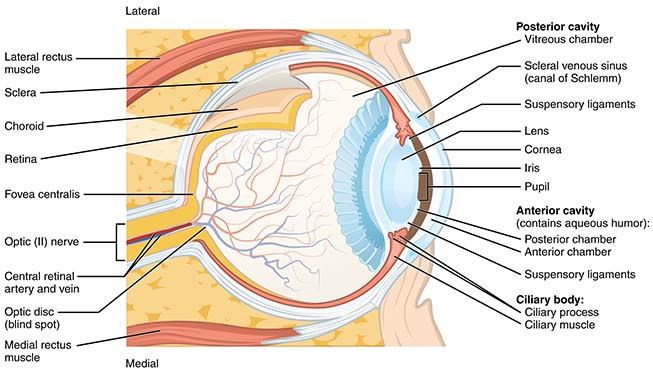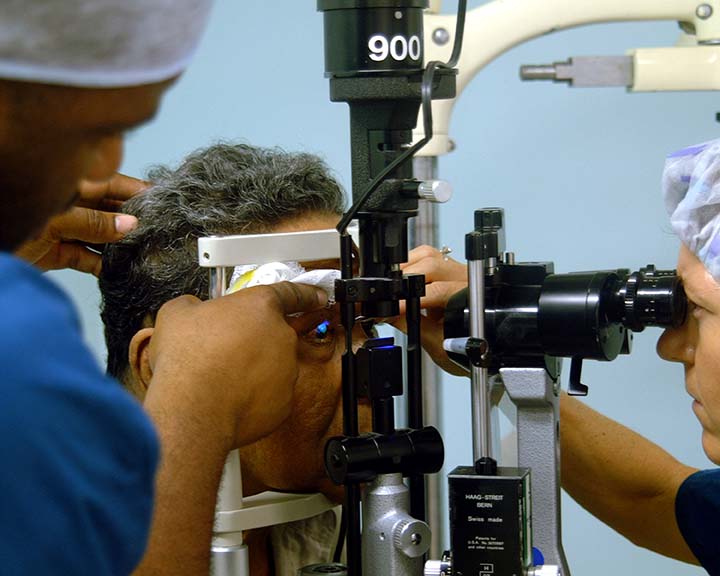- Have any questions? Contact us!
- info@dr-rath-foundation.org

Low Levels Of Omega-3 Fatty Acids Linked To Preterm Birth
August 13, 2018
Hospital Sepsis Deaths In England ‘Jump By A Third’
August 16, 2018The Cellular Medicine Approach To Preventing And Controlling Common Eye Diseases

According to the World Health Organization (WHO), an estimated 253 million people worldwide suffer from visual impairment, of whom 36 million are blind. Some 81% of people who are blind or who suffer moderate to severe vision impairment are aged 50 and over. While visual impairment is a major global health issue, use of the Cellular Medicine approach can help halt and reverse this epidemic.
The anatomy of the eye

By OpenStax College [CC BY 3.0 (https://creativecommons.org/licenses/by/3.0)], via Wikimedia Commons
- The cornea, the clear tissue in the very front of the eye, which refracts light entering the eye.
- The iris, the coloured part of the eye that surrounds the pupil and controls how much light enters it.
- The pupil, the dark spot in the centre of the iris, allows light to enter and be focused on the retina.
- The lens is a small, clear disk inside the eye that sends light rays onto the retina.
- The retina lines the back of the eye, senses light and creates electrical impulses that connect with the brain via the optic nerve.
- The optic nerve runs from eye to brain and carries the electrical impulses formed by the retina to the visual cortex.
- The vitreous body or vitreous humor is a gel filling the space between the lens and the retina, clear enough for light to pass through. It helps the eye to maintain its round shape, but shrinks with age.
- The blind spot is a small portion of the visual field where the optic nerve and the blood vessels leave the eye, and where a lack of receptors makes for restricted optical information transfer.
Common eye diseases and conventional treatments

By U.S. Navy photo by Photographer’s Mate Marjorie McMillen. [Public domain], via Wikimedia Commons
Diseases of the eye range from the uncomfortable and irritating to those that may result in a partial or complete loss of vision. The most common ones include the following:
1. Glaucoma
Glaucoma describes a group of eye diseases that develop as a result of elevated intraocular pressure (IOP) inside the eye. This increased pressure damages the optic nerve and can cause vision loss. Conventional medicine treats glaucoma with chemical eye drops and pills, laser surgery, traditional surgery or a combination of these.
2. Cataracts
A cataract is a clouding of the lens in the eye, which causes blurry vision. It is a typical degenerative disease and most people who live long enough will have some degree of cataract. The condition may be caused by high blood pressure, eye injury, smoking, alcohol abuse, long-term use of corticosteroid medications, or excessive exposure to sunlight. Cataracts tend to occur earlier and develop faster in patients with diabetes. The medical establishment regards surgery to remove the clouded lens as the only effective cure.
3. Age-related macular degeneration (AMD)
As the name suggests, this is another degenerative disease. Commonly occurring after age 50, it slowly but steadily destroys the macula, the part of the retina responsible for sharp, detailed central vision. There are wet and dry types of AMD: In wet AMD, abnormal blood vessels behind the retina start to grow and to leak blood and eye fluid. In the more common dry AMD, small deposits form on the retina, beneath the macula, causing it to deteriorate over time. A common clinical treatment for wet AMD is a periodic injection into the eyeball of a chemical known as an “anti-VEGF” (vascular endothelial growth factor) agent. Such chemicals inhibit the growth of new blood vessels. However, according to a review published in 2013, “intravitreal injection of anti-VEGF agents may be associated with devastating complications”.
4. Torn or detached retina
A retinal tear or detachment is a medical emergency in which the retina detaches from the back of the eye. Retinal detachments are mostly painless. Symptoms may include seeing flashing lights, floaters, or a dark “curtain” descending over the visual field. Treatments include laser and other forms of surgery. Cryotherapy is also used, in which the area of the retina surrounding the tear is frozen. This creates a scar that helps seal the tear and secure the retina to the wall of the eye.
5. Conjunctivitis (pink or red eye)
Conjunctivitis is characterised by redness and inflammation of the eye and the inside of the eyelid, which may feel gritty, burn or itch and produce pus. It is commonly caused by bacterial or viral infections or allergy. Conventional treatment includes strong antibiotic eye drops and, in case of allergy, anti-allergy medication.
6. Uveitis
Uveitis is inflammation to the middle layers of the eye (the uvea) and causes a dull ache in or around the eye. Anti-inflammatory or antibiotic drops, (anti-inflammatory) corticosteroids such as prednisolone, along with pain medications are often prescribed.
7. Eye allergies
Allergies can cause chronic inflammation that permanently damages the cornea. Conventional treatments include antihistamines and anti-inflammatories.
8. Stye (hordeolum)
A stye is usually caused by a bacterial infection of an oil gland at the root of an eyelash. It looks like a large, red pimple on the edge of the eyelid and may be filled with pus, causing pain and swelling. Owing to the swelling of the eyelid the eyeball often feels irritated. Conventional medicine treats the symptoms mostly with antibiotic cream or eye drops, and, if the infection spreads beyond the eyelid, possibly with oral antibiotics.
9. Blepharitis
This describes inflammation of the rims of the eyelids, caused by a reaction to staphylococcus bacteria or by blocked glands resulting from seborrheic dermatitis. It may affect the outer or inner eyelid. Symptoms include burning, itching, swelling, crusting of the eyelids and blurred vision. If the condition does not respond to regular cleaning, the patient may be prescribed antibiotic ointments, creams or eye drops.
10. Chalazion (eyelid cyst)
A chalazion (meibomian cyst, tarsal cyst, or conjunctival granuloma) is a bump inside the eyelid caused by a blocked oil gland. It is usually painless unless it becomes inflamed. Where the condition persists or recurs, or there are multiple lesions, treatment might entail anti-inflammatory and antibiotic drops or ointments, surgical removal or an injection of corticosteroids.
11. Corneal ulcer
This is a small crater on the front part of the eye, most usually caused by a bacterial, viral or fungal infection, with the potential to cause devastating loss of vision. Contact-lens wearers are at increased risk. Treatments include antibiotics and anti-inflammatories.
12. Diabetic Retinopathy
People with diabetes have multiple disease symptoms caused by the constantly elevated blood sugar levels that poison the entire body, and the eyes are no exception. With retinopathy there may be bleeding in the retina and leakage of blood or serum into the eyeball. In addition to conventional treatment for managing diabetes, laser treatment, eye injections and surgery are used.
The Cellular Medicine approach to eye diseases
The Cellular Medicine approach to preventing and controlling eye diseases is based on providing an optimum supply of essential micronutrients to the cells of the eye and its various anatomical components.
In addition to following Dr. Rath’s Basic Cellular Health Recommendations, a supplementary intake of the following micronutrients has been shown in scientific studies to be particularly helpful:
| Antioxidants such as vitamins C and E, beta carotene and zinc have been shown to help with advanced AMD. Based on a study involving more than 3,500 participants aged 55-80, researchers concluded that people older than 55 who showed risk factors for advanced AMD should consider taking a supplement containing antioxidants and zinc. |
| There is also substantial evidence that vitamin C lowers the risk of developing cataracts. A study in randomly sampled villages in India, involving 5,638 participants aged 60 or more, found “a strong association with vitamin C and cataract in a vitamin-C-depleted population”. |
| Beta carotene, a carotenoid, is a precursor of vitamin A. A deficiency of vitamin A can cause night blindness, clouding of the front of the eye, corneal ulcers and retinal damage. Research has shown people with higher carotenoid intake have a long-term reduced risk of advanced AMD. |
| Polyphenols from grapes are also known to promote eye health. |
| A study of the effect of the amino acid L-arginine on intraocular pressure (IOP) in the human eye has shown that it lowers such pressure, mainly through the formation of nitric oxide. |
| In a study of patients having eye surgery for myopia (nearsightedness), those taking oral L-cysteine supplements in addition to a specific type of eye drops showed more rapid corneal healing. |
| In patients with diabetes, alpha-lipoic acid has been shown to improve contrast sensitivity (the ability to see objects that do not stand out from their background or which are not clearly outlined). |
| Lutein also plays a significant role in maintaining eye health. A scientific review published in the journal Nutrients in 2013 concluded that its antioxidant, anti-inflammatory and blue light-absorptive properties provide many protective roles in ocular diseases such as AMD and cataracts. |
If you have any questions about eye health, you are welcome to contact us at any time.



